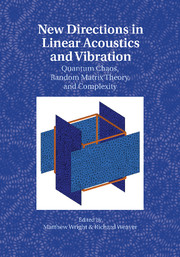Book contents
- Frontmatter
- Contents
- Foreword by Michael Berry
- Introduction
- 1 The Semiclassical Trace Formula
- 2 Wave Chaos for the Helmholtz Equation
- 3 The Unreasonable Effectiveness of Random Matrix Theory for the Vibrations and Acoustics of Complex Structures
- 4 Gaussian Random Wavefields and the Ergodic Mode Hypothesis
- 5 Short Periodic Orbit Theory of Eigenfunctions
- 6 Chaotic Wave Scattering
- 7 Transfer Operators Applied to Elastic Plate Vibrations
- 8 Mesoscopics in Acoustics
- 9 Diagrammatic Methods in Multiple Scattering
- 10 Time-Reversed Waves in Complex Media
- 11 Ocean Acoustics: A Novel Laboratory for Wave Chaos
- 12 Mesoscopic Seismic Waves
- 13 Random Matrices in Structural Acoustics
- 14 The Analysis of Random Built-Up Engineering Systems
- References
- Index
7 - Transfer Operators Applied to Elastic Plate Vibrations
Published online by Cambridge University Press: 05 October 2010
- Frontmatter
- Contents
- Foreword by Michael Berry
- Introduction
- 1 The Semiclassical Trace Formula
- 2 Wave Chaos for the Helmholtz Equation
- 3 The Unreasonable Effectiveness of Random Matrix Theory for the Vibrations and Acoustics of Complex Structures
- 4 Gaussian Random Wavefields and the Ergodic Mode Hypothesis
- 5 Short Periodic Orbit Theory of Eigenfunctions
- 6 Chaotic Wave Scattering
- 7 Transfer Operators Applied to Elastic Plate Vibrations
- 8 Mesoscopics in Acoustics
- 9 Diagrammatic Methods in Multiple Scattering
- 10 Time-Reversed Waves in Complex Media
- 11 Ocean Acoustics: A Novel Laboratory for Wave Chaos
- 12 Mesoscopic Seismic Waves
- 13 Random Matrices in Structural Acoustics
- 14 The Analysis of Random Built-Up Engineering Systems
- References
- Index
Summary
In ray approximations of boundary integral kernels, unitary transfer operators arise. The existence of transfer operators implies trace formulas for the fluctuating part of the spectral density and due to unitarity a reduction of the number of periodic orbits used in these formulas. We introduce the transfer operator method and discuss its applications in elasticity in the case of plate vibrations.
Introduction
In the construction of fluctuating spectral densities (Gutzwiller 1990, Brack & Bhaduri 1997, Stöckmann 1999), the physicist Gutzwiller took a trace of a unitary evolution operator, the Green's function in path integral form. The resulting trace formulas are expressed as a sum over periodic orbits. Later, in the setting of resonators it was discovered that the more conventional boundary integral kernels (Kitahara 1985, Bonnet 1995) could do the same job and that these kernels could also be made unitary.
One such approach is the transfer matrix of Bogomolny (Bogomolny 1992, Boasman 1994). Such ray kernels contain the essence of semiclassical approximations and can be used for numerics even without periodic orbits. Furthermore, these operators are unitary, leading to a truncation in the trace formula (called resurgence) of the infinitely many periodic orbits of the system in question (Berry & Keating 1990, Georgeot & Prange 1995). Another unitary approach is inside–outside duality based on scattering (Smilansky 1995, Smilansky & Ussishkin 1996).
Information
- Type
- Chapter
- Information
- New Directions in Linear Acoustics and VibrationQuantum Chaos, Random Matrix Theory and Complexity, pp. 110 - 122Publisher: Cambridge University PressPrint publication year: 2010
